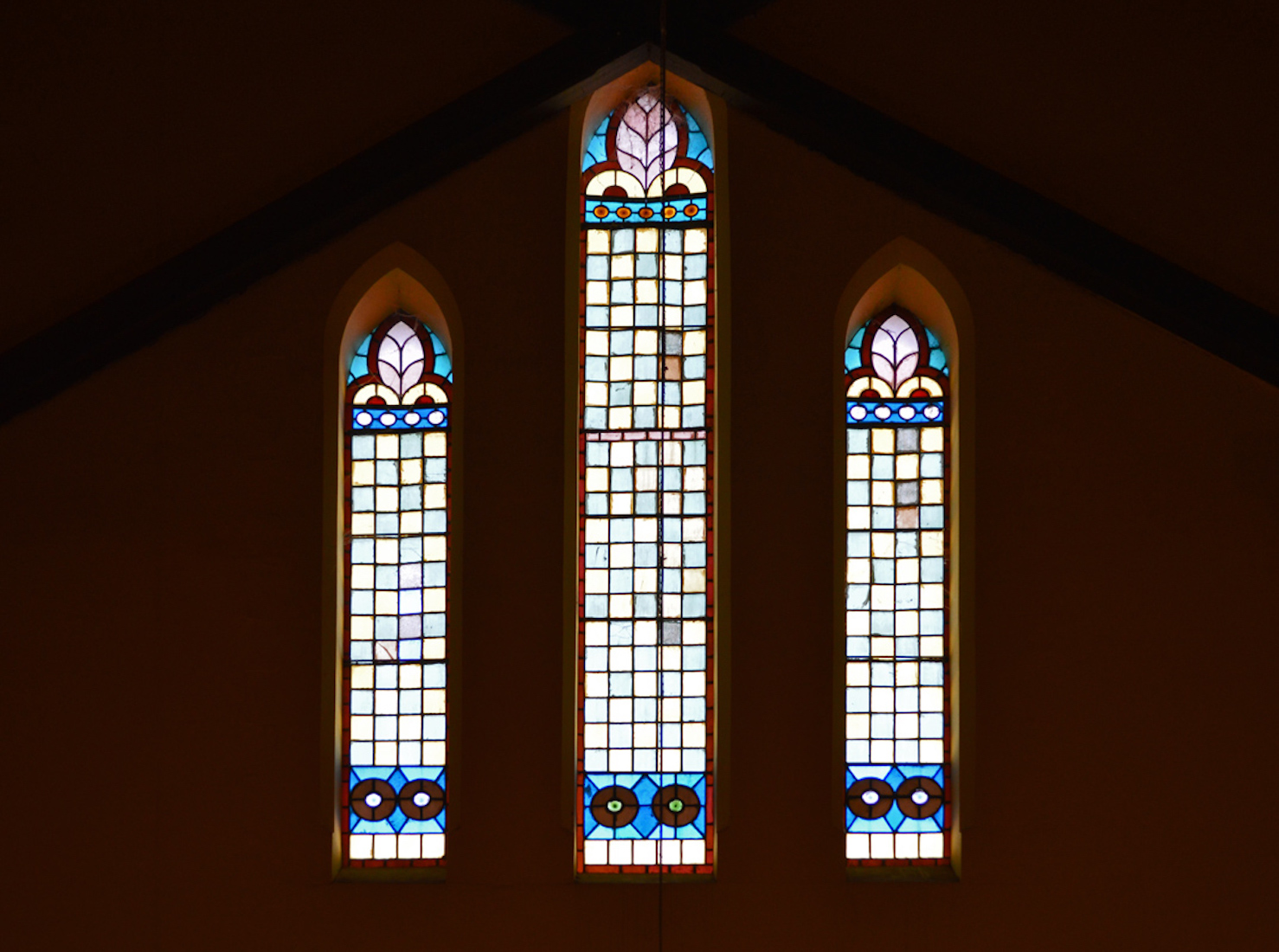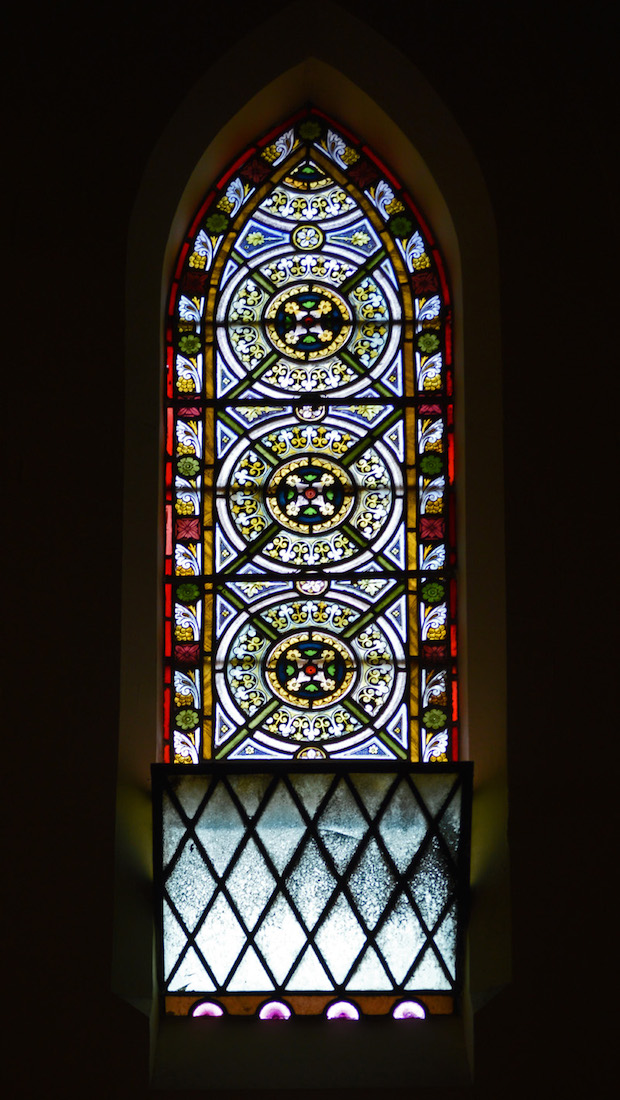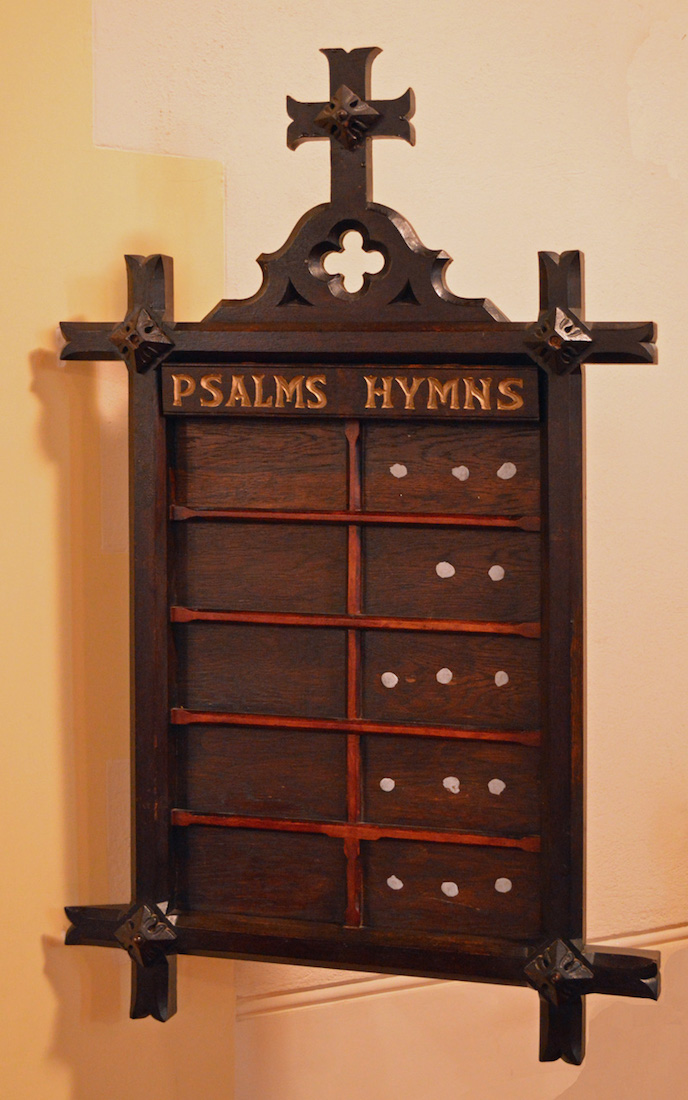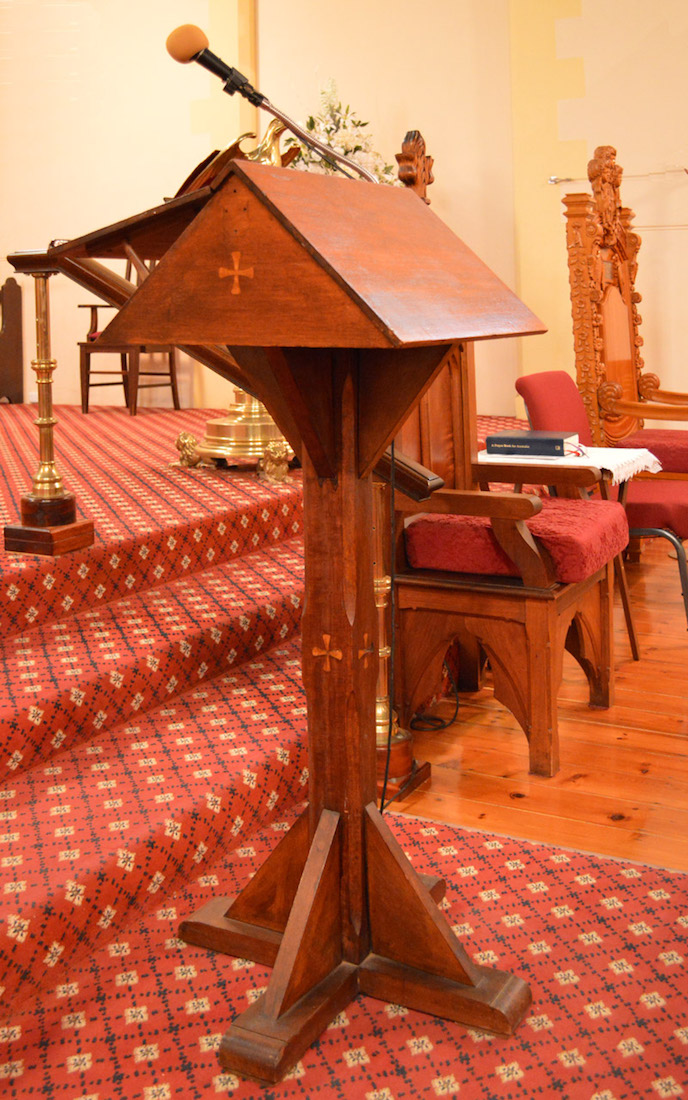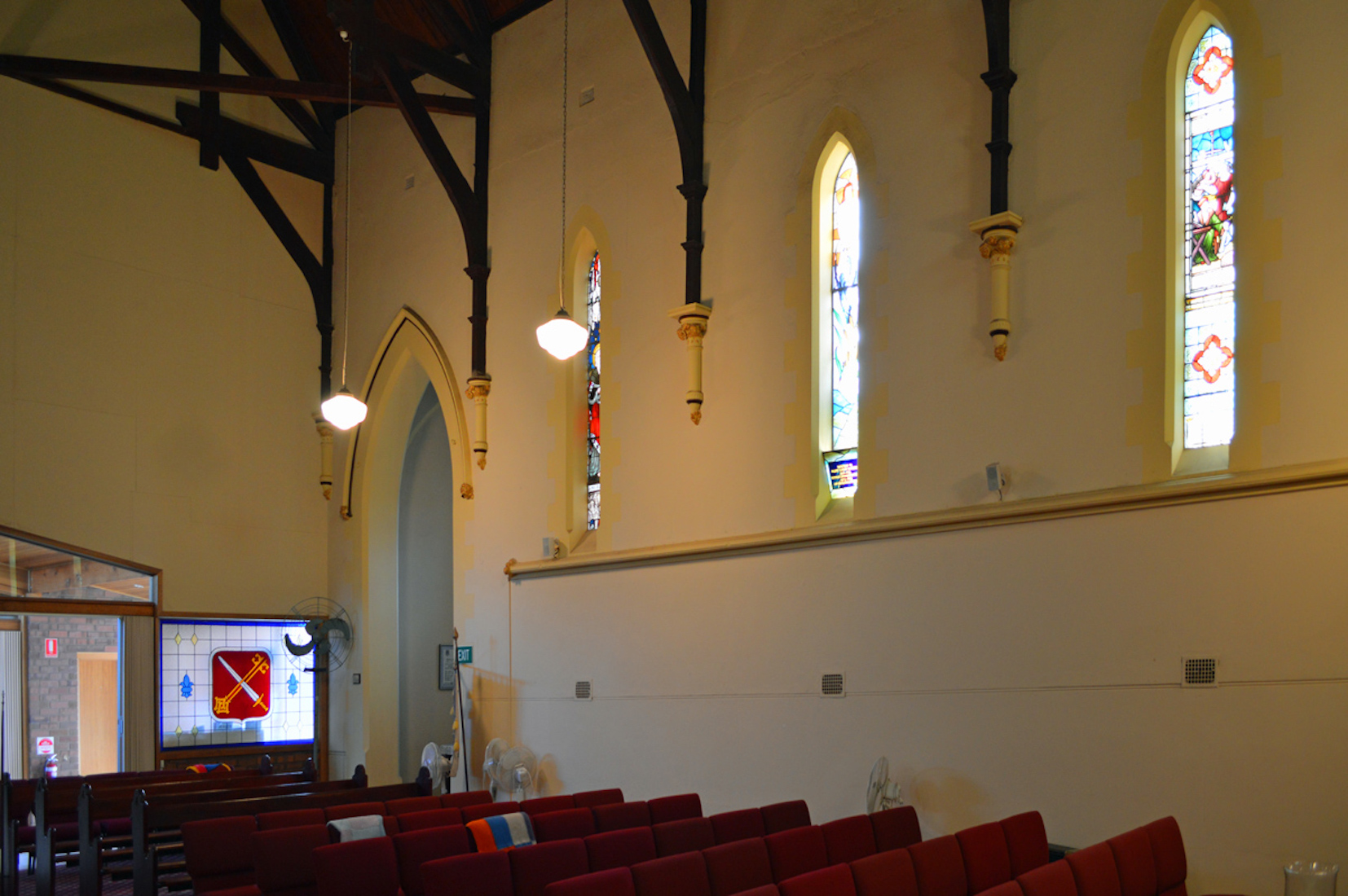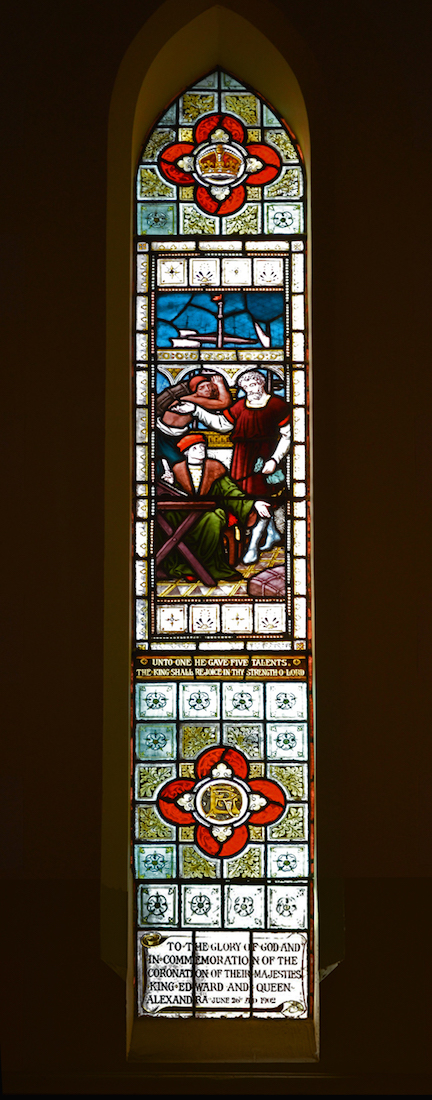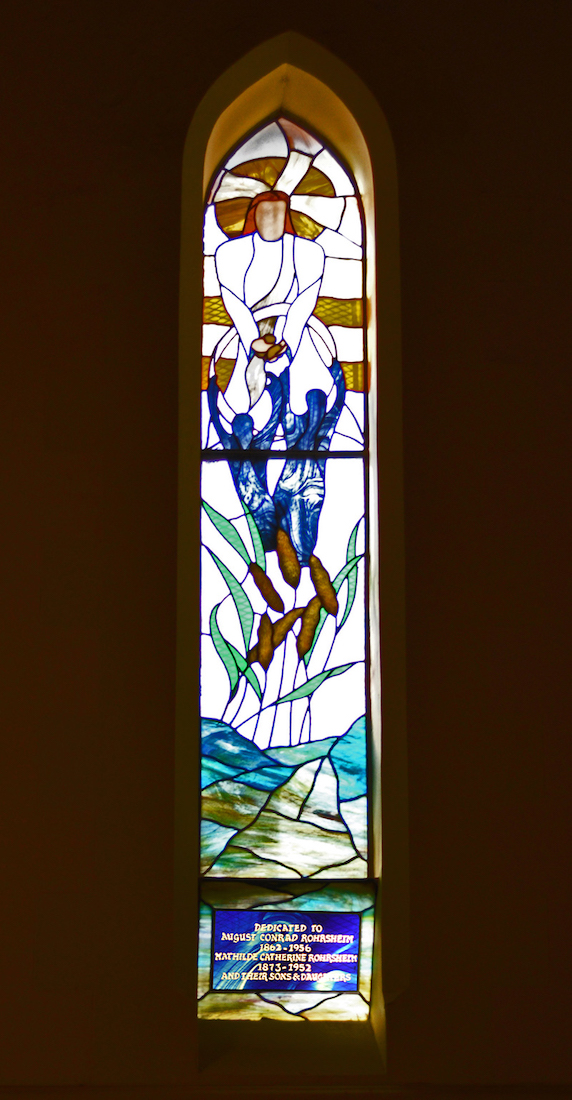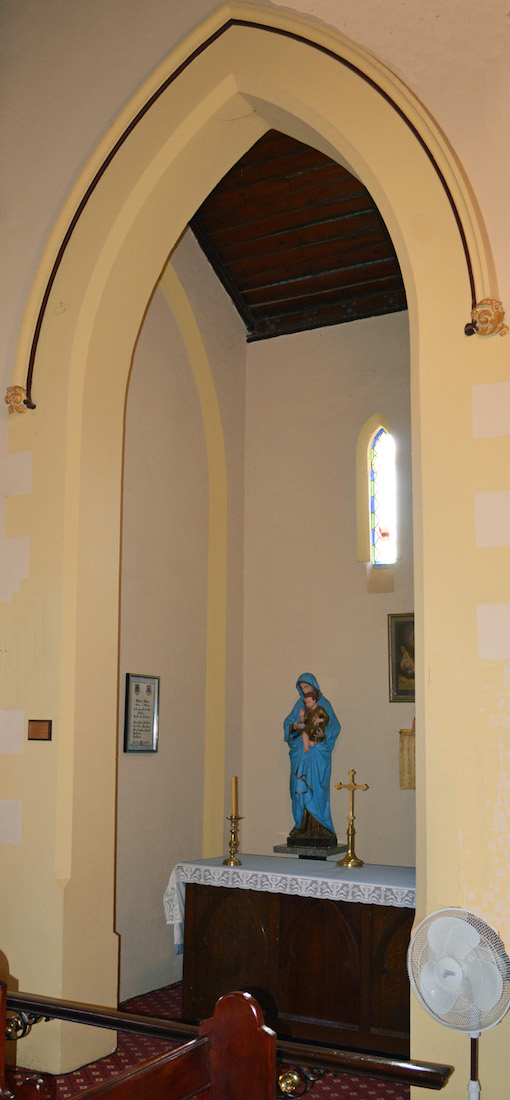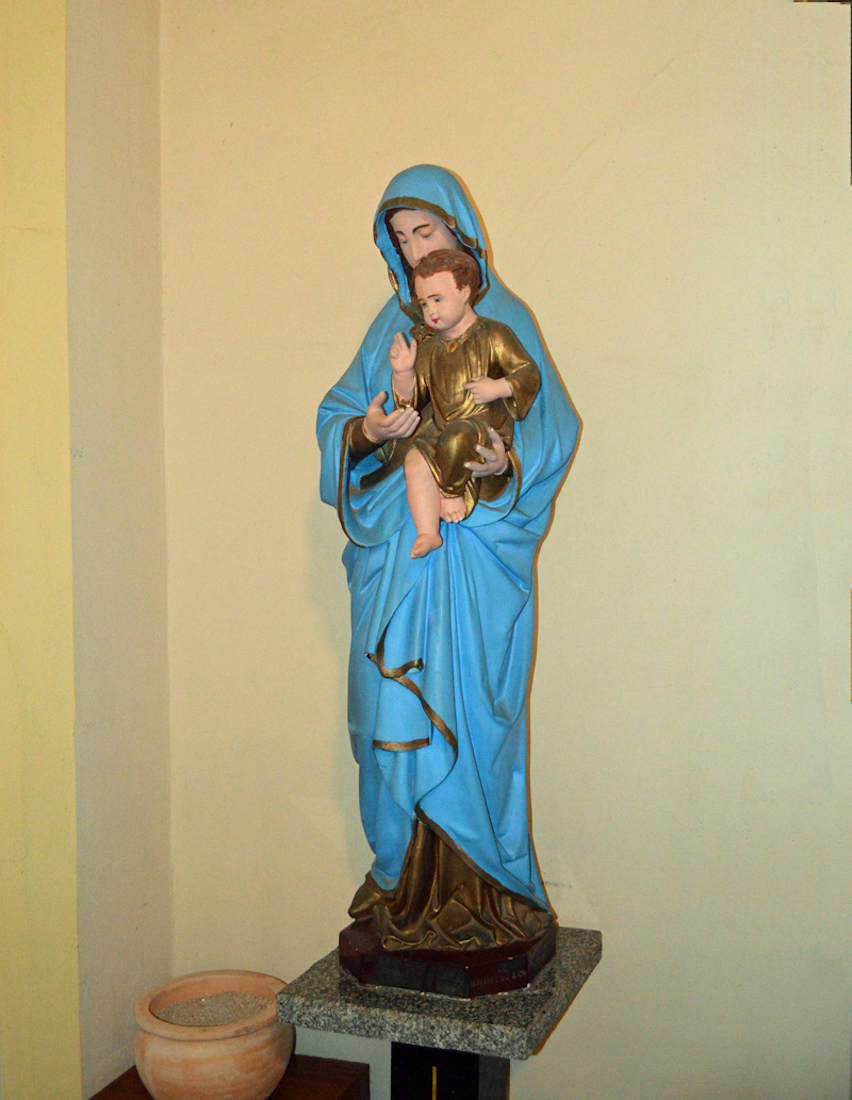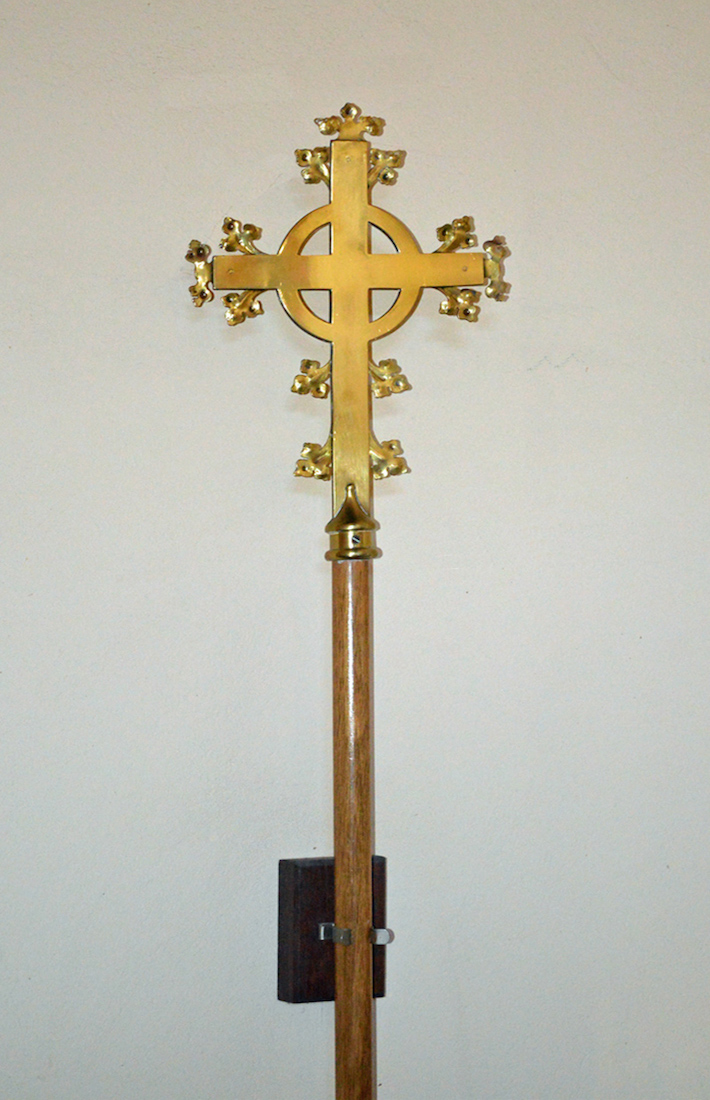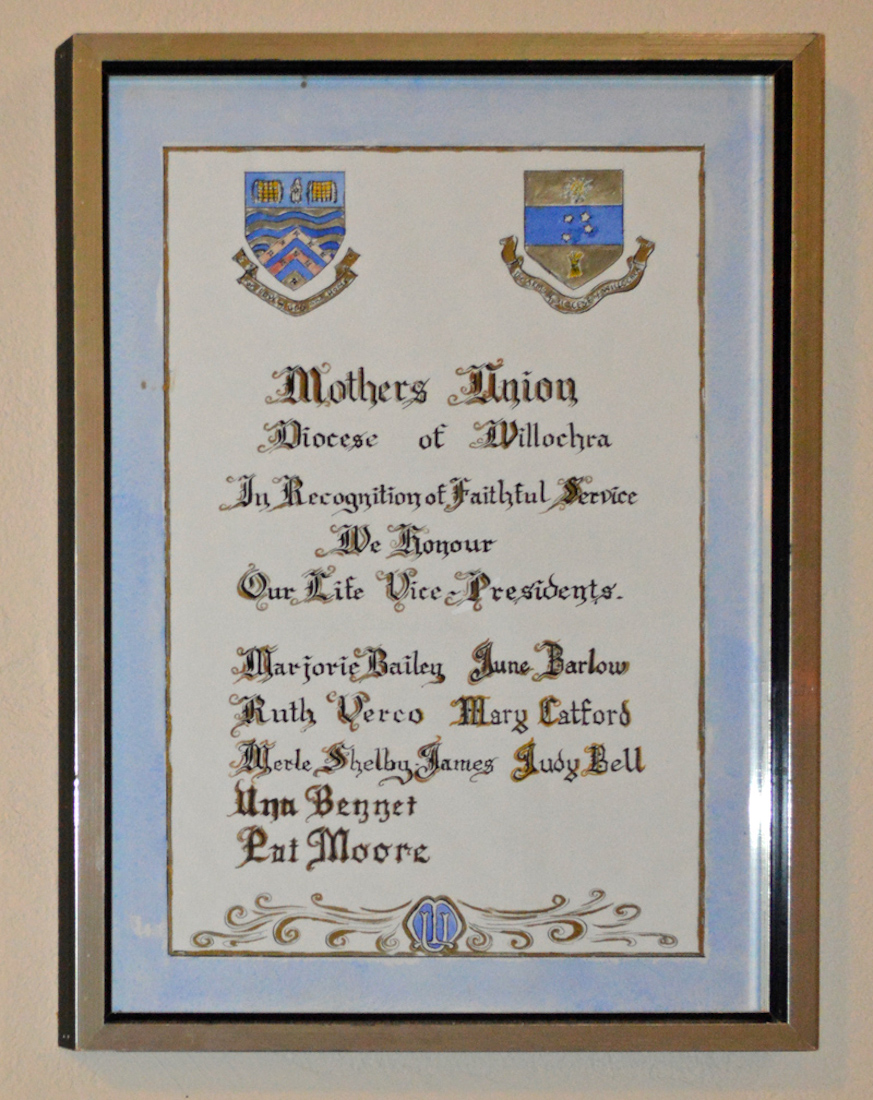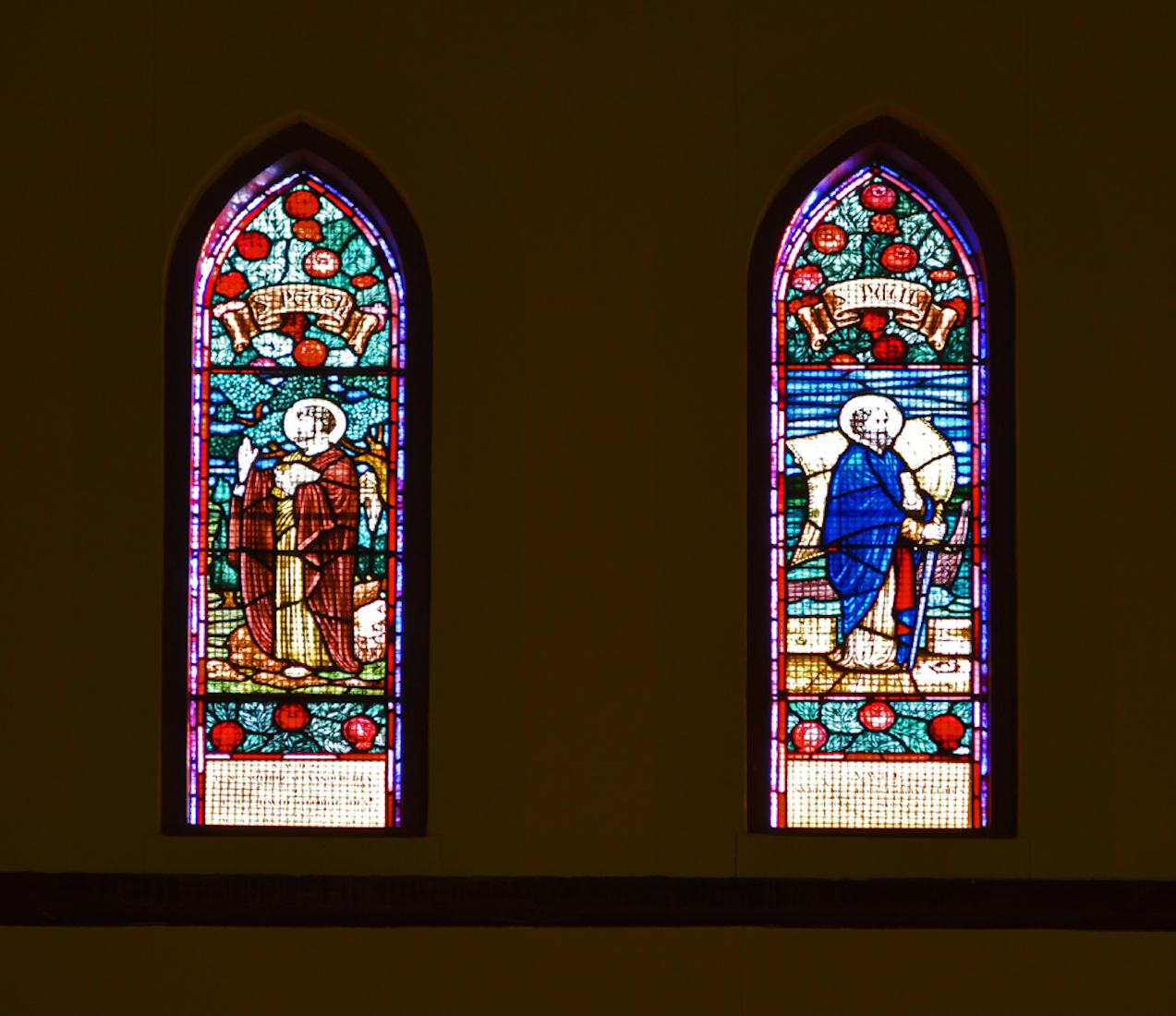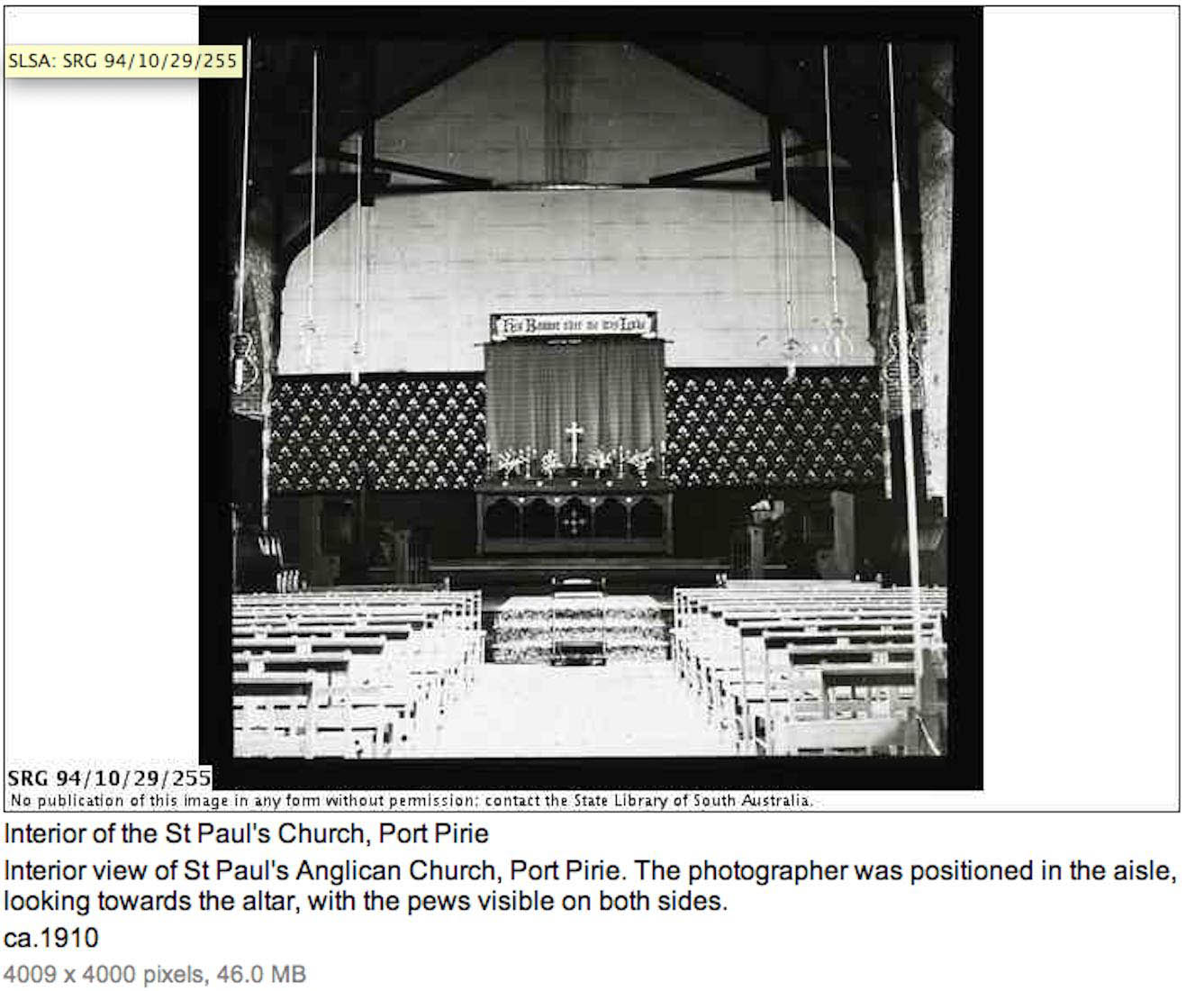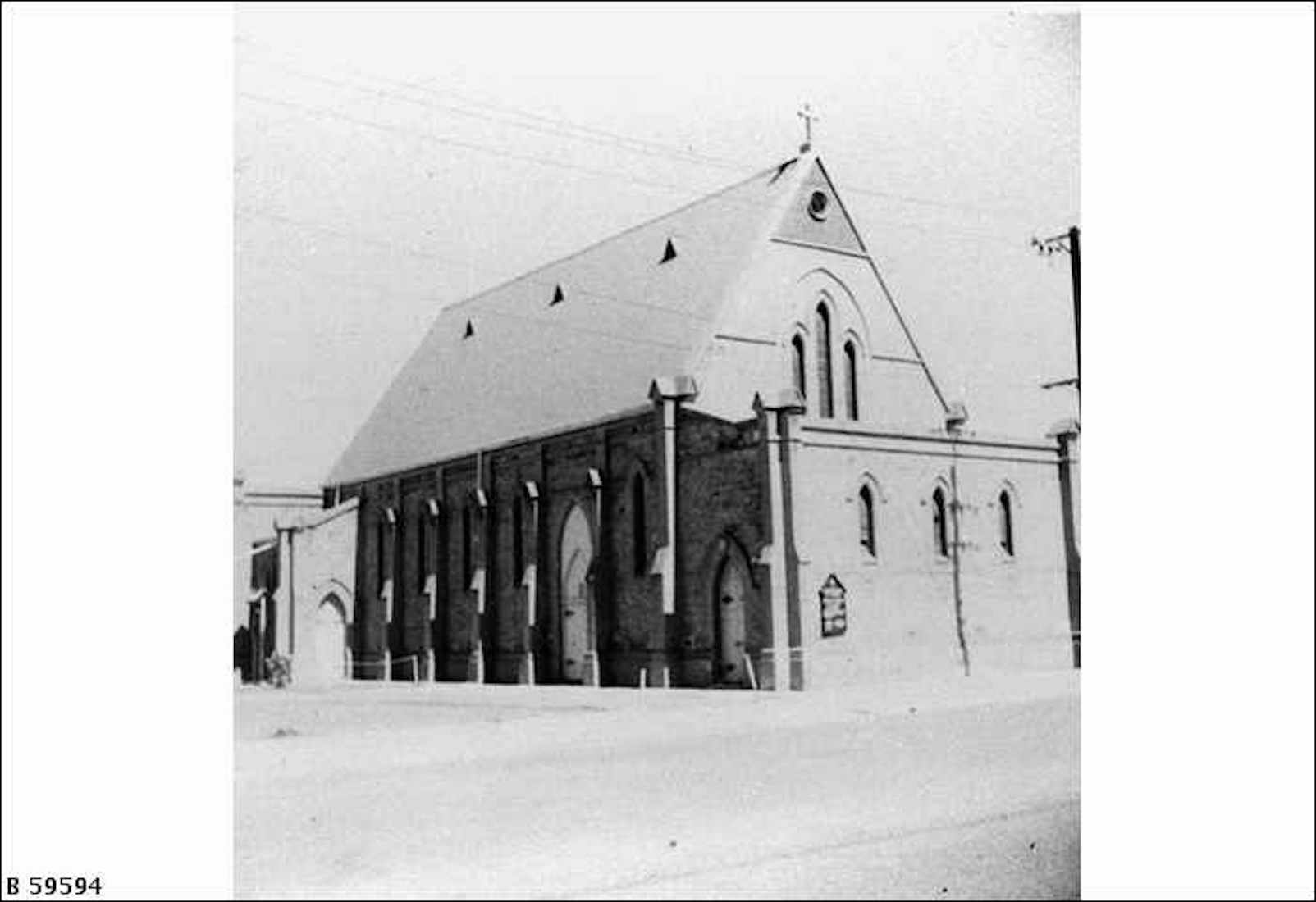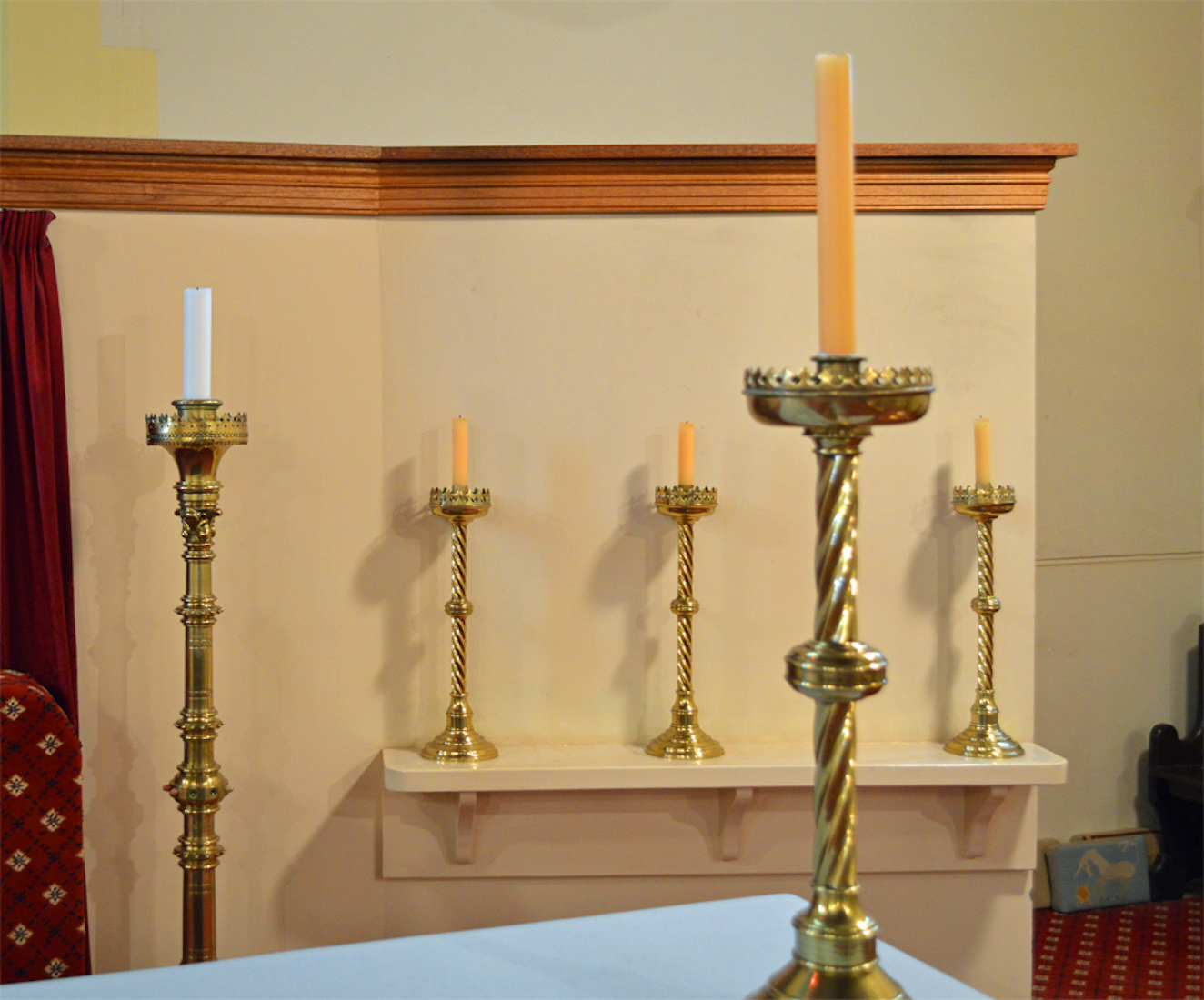
More generally, candles speak of light with the allusion to Jesus being the Light of the world. INDEX
42. SANCTUARY LAMP
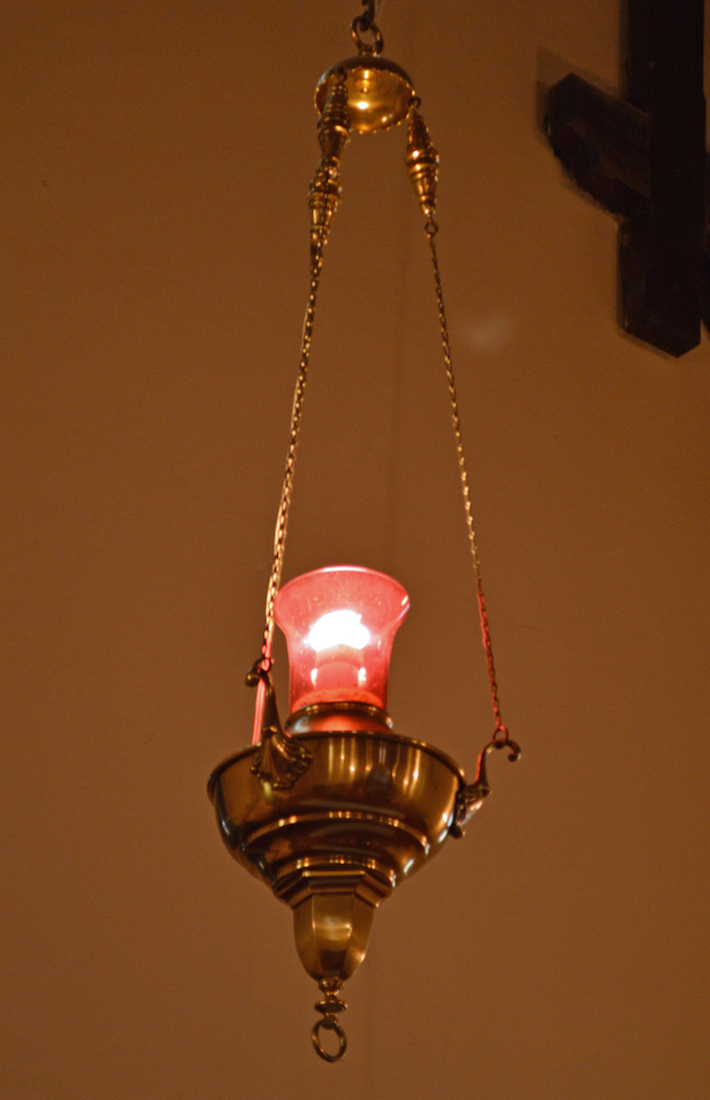
Every cathedral has its own sanctuary lamp, burning to symbolize the presence of God. In Exodus 27:20, these words are written about the tabernacle: ‘And thou shalt command the children of Israel, that they bring thee pure olive oil beaten for the light, to cause the lamp to burn always.’ The sanctuary lamp is almost always red, to distinguish it from the other votive lights which appear in some churches..
43. HIGH EAST WINDOWS
High in the East wall are three lancet windows. Each window has an emerging leaf design at its apex, a blue and brown design at the base, and is predominantly a pattern of plain lattice squares. The windows appear to have suffered some damage over the years.
44. EAST LOW CENTRAL WINDOW
In the lower East wall of this Cathedral there are three windows. The central window depicts the risen Christ. Across the base is the inscription: ‘In memorium Thomas Benjamin Terrell’.
45. EAST LOW SIDE WINDOW
On either side are identical attractively patterned stained glass windows. It is possible that these are also ‘In memorium’ windows, but the opening bottom fanlights made it impossible to tell.
46. HYMN BOARD
Returning to the main body of the Cathedral we notice the carved hymn board on the North wall.
47. WOODEN LECTERN
There is also an interesting wooden lectern with its adjustable reading panel. This looks as though it might have some interesting history!
48. NORTH WALL
Turning, we look back along the North nave, noting the various stained glass windows, and also the Gothic entryway to the Lady Chapel.
49. NORTH WINDOW EAST
The scene depicted in this Eastern-most window is clear from the text below: ‘Unto one he gave five talents. The King shall rejoice in thy strength, O Lord.’ The inscription below reads: ‘To the glory of God and in commemoration of their Majesties King Edward and Queen Alexandra June 26 AD 1902. [In fact, the date was August 9: the occasion was postponed!]
50. NORTH WINDOW CENTRAL
The next window ... how does one interpret the work of the artist? Perhaps Christ feeding bread to the crowds on the shore of the Lake of Galilee? The top central inscription gives the dedication of this window.
51. NORTH WINDOW WEST
The remaining window depicts St Andrew, and there is no further inscription. Saint Andrew’s birthdate and place of birth are unknown. During his lifetime, he became a disciple of John the Baptist, one of the Twelve Apostles, and the first of Christ’s disciples. Saint Andrew and his brother Peter are recorded in the New Testament as having been declared ‘fishers of men’ by Jesus after he asked them to cast their nets. Saint Andrew was crucified ca 70 in Patras, Achaia, Greece.
52. MOTHERS’ UNION BANNER
Banners have an important place in the life of any cathedral. This banner created by the Mothers’ Union shows the Holy Family. It stands at the entrance to the Lady Chapel.
53. LOW WEST WINDOW
This stained glass window is placed on the West side of the entrance to the Lady Chapel. The key here represents St Peter. This is because Christ said to St. Peter that he would give him the 'keys of the kingdom' and that whatever he bound on earth, would be bound in heaven, and whatever he loosed on earth, would be loosed in heaven. (Matthew 16,19). The sword represents St Paul. This is because St. Paul is usually depicted with a sword – a symbol of the 'sword of faith' – the weapon used against the devil.
55. MARY AND JESUS
Christians believe that she conceived her son miraculously by the agency of the Holy Spirit. The Bible records Mary’s role in key events of the life of Jesus from his conception to his Ascension. Mary is usually shown wearing blue – a sign of purity.
56. ICON
Also central in the Lady Chapel is this painting of Madonna and Child. Below the painting is a small sanctuary lamp above an aumbry – a niche where the reserved sacrament (the consecrated elements of the Eucharist) are kept.
57. CROSS
Also in the Lady Chapel is this unusual ceremonial cross. The circle shows a Celtic influence, and the buds are reminiscent of the fleurs-de-lis, symbol of new life.
58. MOTHERS’ UNION CERTIFICATE
The certificate is in honour of the Life Vice Presidents of the Mothers’ Union in the Diocese.
59. HIGH WINDOWS
Stepping back into the nave, we look up to the high windows of the West wall. At left is St Peter, and at right is St Paul. It would be interesting to know the date and origin of these windows, given that this Cathedral was originally St Paul’s.
60. INTERIOR IN 1910
We conclude our tour of this Cathedral with two old photographs. ••• In 1898 W.K. Mallyon, a local bank manager, designed a new Anglican Church for Port Pirie which was rapidly expanding after the opening of the lead smelter. It was built on the corner of Florence and David Streets next to the old St. Paul’s timber church. The foundation stone was laid on the 17th August 1899 by the Right Rev. John Reginald Harmer, Lord Bishop of Adelaide, with the Port Pirie Lodge taking a prominent part in the ceremony. The congregation of St.Peter’s from Balmoral Road, Risdon Park amalgamated with St. Paul’s after St. Peter’s closed in 1980. Bishop Rosier rededicated the Church as St. Peter and St. Paul. [Photo Credit : slsa : St Paul’s Interior ca 1910 : SRG 94/10/29/255 ]
61. CHURCH IN 1945
The memorial window from St. Peter’s is transferred and installed above the altar (now at the back of the church since it has been turned around). In 1996 the interior of the church was completely refurbished with the addition of a new church hall and kitchen. Bishop McCall laid the foundation stones for the new buildings on 25th May 1996 and work was completed by November. St.Peter and St. Paul’s church was proclaimed the Cathedral Church of the Diocese of Willochra on Tuesday 29th June by Bishop David McCall. This completes our tour of this Cathedral.

CONCLUSION
I hope you have enjoyed our tour of the Cathedral of Ss Peter and Paul, Port Pirie. After completing a project like this, I am always conscious of things I have missed! Also, on this website, there are some pages where further information should be added. So if you have some favourite photograph or extra information you would like to add here, I would be delighted to hear from you.
I am grateful to Mrs Pauline Matthews from the Cathedral who has gone to some trouble finding extra details for me. I am also grateful to my wife Margie for some final proof-reading, but if there are any further typos, or factual errors, please feel free to contact me. The best websites are those which contain no errors!
A collection of my photos used on this site can be found at
https://www.flickr.com/photos/paulscottinfo/albums/
The Cathedral has a Facebook page at
https://www.facebook.com/flindersplainanglicans/
Site completed 08 / 2013 ; revised 03 / 2016 ; reformatted 11 / 2020
Paul Scott

